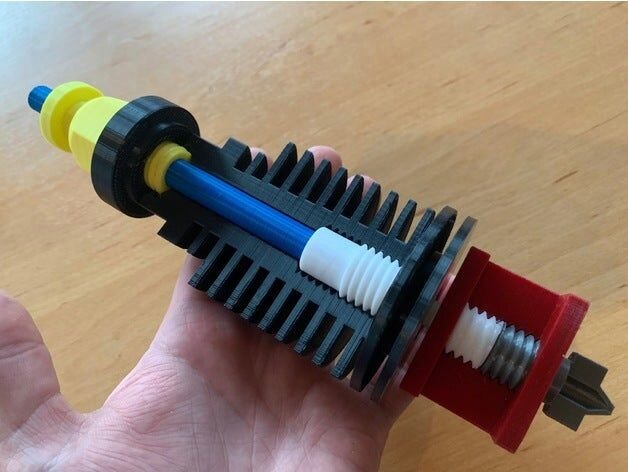![A giant 3D printed 3D printer hot end [Source: Thingiverse]](https://fabbaloo.com/wp-content/uploads/2020/05/image-asset_img_5eb08d78eb757.jpg) A giant 3D printed 3D printer hot end [Source: Thingiverse]
A giant 3D printed 3D printer hot end [Source: Thingiverse]
This week’s selection is the Giant Hot End by Thingiverse contributor Hiob.
This is exactly what it seems to be: a gigantic replica of a 3D printer hot end, normally used to soften filament before extrusion. In fact, it’s a representation of the very popular E3D-Online V6 hot end, which is a component in many desktop 3D printers today.
Hiob’s design is actually a remix of an original work, also posted on Thingiverse, by designer HobbyHoarder.
Educational Hot End
Why make such a thing? It’s for educational purposes. Hiob explains:
“Friends, acquaintances, relatives and colleagues ask you how 3D printing actually works!
With this model it’s easier for me to explain a hotend!”
You might be thinking that this is type of model is not required, as a hot end is a straightforward component: it just squirts out material, doesn’t it?
If that’s what you’re thinking, you haven’t ever taken apart a hot end to repair it. A hot end is a rather sophisticated component that is very carefully designed.
Why is a hot end challenging to design? It’s because of the precision required to manage heat flows in a hot end. In a way, a hot end is a bit of a paradox.
![A giant 3D printed 3D printer hot end [Source: Thingiverse]](https://fabbaloo.com/wp-content/uploads/2020/05/image-asset_img_5eb08d7950aa2.jpg) A giant 3D printed 3D printer hot end [Source: Thingiverse]
A giant 3D printed 3D printer hot end [Source: Thingiverse]
Hot End Paradox
The hot end absolutely must heat the filament to a very narrow temperature range on demand, and do so quickly. Yet, at the same time it must also maintain cool temperatures.
Cool temperatures must be maintained in order to prevent “heat creep”, where stray heat leaks upwards and possibly melts filament in an area where it should not melt. This is one of the major causes of 3D printer jams, and it can be quite difficult to fix, depending on exactly where the jam occurred.
The hot end is divided into two zones: hot and cold to accomplish this division of function, with the two zones being thermally separated with a small component called the heatbreak.
Heatbreak Design
![A giant 3D printed 3D printer hot end [Source: Thingiverse]](https://fabbaloo.com/wp-content/uploads/2020/05/image-asset_img_5eb08d79b9e75.jpg) A giant 3D printed 3D printer hot end [Source: Thingiverse]
A giant 3D printed 3D printer hot end [Source: Thingiverse]
The heatbreak is specifically designed to reduce the transfer of heat from the hot zone to the cold zone. It connects the two zones directly with a threaded link, but at the same time tries to minimize the amount of metal material used to do so in order to reduce thermal transfer capacity.
As you can see, the design of the hot end is actually rather complex, and having a 3D model on hand to explain the concepts could be very useful. You can take apart the model and point out the functions of each of its structures.
And it’s just fun to print, too.
Via Thingiverse

